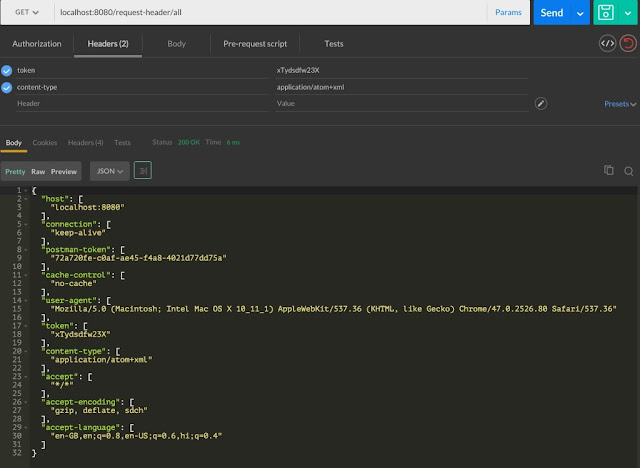In the previous post, we talked about, how to get parameters and their values from the request query string. In this guide learn how to get request header values in Jersey (JAX-RS) based application.
We had tested or used the following tools and technologies in this project:
- Jersey (v 2.21)
- Gradle Build System (v 2.9)
- Spring Boot (v 1.3)
- Java (v 1.8)
- Eclipse IDE
This is a part of Jersey (JAX-RS) Restful Web Services Development Guides series. Please read Jersey + Spring Boot getting started guide.
Gradle Build File
We are using Gradle for our build and dependency management (Using Maven rather than Gradle is a very trivial task).
File: build.gradle
buildscript {
ext {
springBootVersion = '1.3.0.RELEASE'
}
repositories {
mavenCentral()
}
dependencies {
classpath("org.springframework.boot:spring-boot-gradle-plugin:${springBootVersion}")
}
}
apply plugin: 'java'
apply plugin: 'eclipse'
apply plugin: 'idea'
apply plugin: 'spring-boot'
jar {
baseName = 'jersey-request-header'
version = '0.0.1-SNAPSHOT'
}
sourceCompatibility = 1.8
targetCompatibility = 1.8
repositories {
mavenCentral()
}
dependencies {
compile('org.springframework.boot:spring-boot-starter-jersey')
testCompile('org.springframework.boot:spring-boot-starter-test')
}
eclipse {
classpath {
containers.remove('org.eclipse.jdt.launching.JRE_CONTAINER')
containers 'org.eclipse.jdt.launching.JRE_CONTAINER/org.eclipse.jdt.internal.debug.ui.launcher.StandardVMType/JavaSE-1.8'
}
}
task wrapper(type: Wrapper) {
gradleVersion = '2.7'
}
Spring Boot Main Method Class
Spring Boot Main Method Class is the starting point for the Spring Boot-based application just like a normal java application.
File: JerseyRequestParameterApplication.java
package in.geekmj;
import org.springframework.boot.SpringApplication;
import org.springframework.boot.autoconfigure.SpringBootApplication;
@SpringBootApplication
public class JerseyRequestHeaderApplication {
public static void main(String[] args) {
SpringApplication.run(JerseyRequestHeaderApplication.class, args);
}
}
Jersey Configuration Class
Jersey Configuration class is a ResourceConfig class for providing Jersey-specific configuration and Resources entry.
File: JerseyConfig.java
package in.geekmj.config;
import javax.ws.rs.ApplicationPath;
import org.glassfish.jersey.server.ResourceConfig;
import org.springframework.stereotype.Component;
import in.geekmj.resource.RequestHeaderResource;
@Component
@ApplicationPath("/")
public class JerseyConfig extends ResourceConfig {
/*
* In constructor we can define Jersey Resources & Other Components
*/
public JerseyConfig() {
register(RequestHeaderResource.class);
}
}
Reading specific request header using @HeaderParam
File: RequestParameterResource.java
package in.geekmj.resource;
import java.util.HashMap;
import java.util.Map;
import javax.ws.rs.GET;
import javax.ws.rs.HeaderParam;
import javax.ws.rs.Path;
import javax.ws.rs.Produces;
import javax.ws.rs.core.Context;
import javax.ws.rs.core.HttpHeaders;
import javax.ws.rs.core.MediaType;
@Path("/request-header")
@Produces(MediaType.APPLICATION_JSON)
public class RequestHeaderResource {
/*
* We can inject request header as an instance variables using @HeaderParam
*/
@HeaderParam("token")
private String token;
/* We can inject request header values in method using @HeaderParam */
@GET
public Map<String, String> getRequestHeaders(@HeaderParam("content-type") String contentType) {
Map<String, String> requestHeaders = new HashMap<String, String>();
requestHeaders.put("token", token);
requestHeaders.put("contentType", contentType);
return requestHeaders;
}
}
We have used @HeaderParam for injecting specific request headers as instance variables and method parameters.
API URI /request-header can read two headers:
- token
- content-type
In response to this API URI, we show values for these header parameters in JSON structure.
Start Spring Boot Application and test the API using Postman. In Postman we can pass headers. (Refer Spring Boot quick starter guide to understand how to start Spring Boot Application)
Test https://localhost:8080/request-header as shown below in Postman.
!Getting Jersey Request Header ValuesGetting Jersey Request Header Values
Get all request headers in Map
File: RequestParameterResource.java
package in.geekmj.resource;
import java.util.HashMap;
import java.util.Map;
import javax.ws.rs.GET;
import javax.ws.rs.HeaderParam;
import javax.ws.rs.Path;
import javax.ws.rs.Produces;
import javax.ws.rs.core.Context;
import javax.ws.rs.core.HttpHeaders;
import javax.ws.rs.core.MediaType;
@Path("/request-header")
@Produces(MediaType.APPLICATION_JSON)
public class RequestHeaderResource {
/*
* We can get a map of all request headers name and value using HttpHeaders
* context injection
*/
@SuppressWarnings("rawtypes")
@GET
@Path("/all")
public Map getAllRequestHeadersUsingContext(@Context HttpHeaders headers) {
return headers.getRequestHeaders();
}
}
We had used @Context to inject HttpHeaders. HttpHeaders has a method getRequestHeaders which returns a map with Key as header name and value as a header value.
Test https://localhost:8080/request-header/all as shown below in Postman.
References
- What is the HTTP request header? (Wikipedia Article)
- Official Jersey Documentation
- Download the Full Project
- Follow Project On Github
